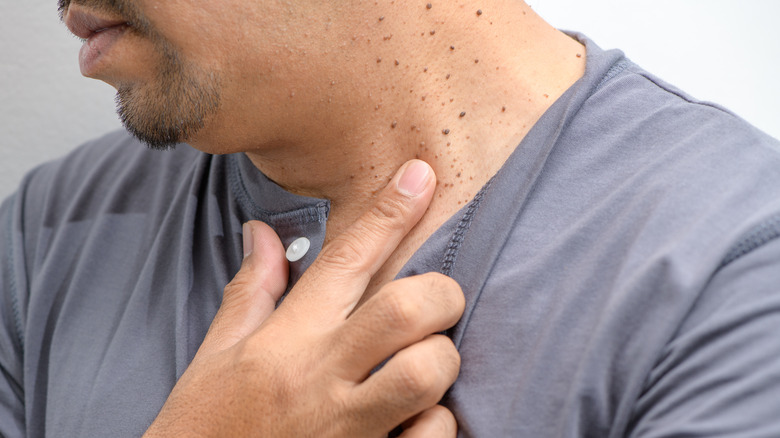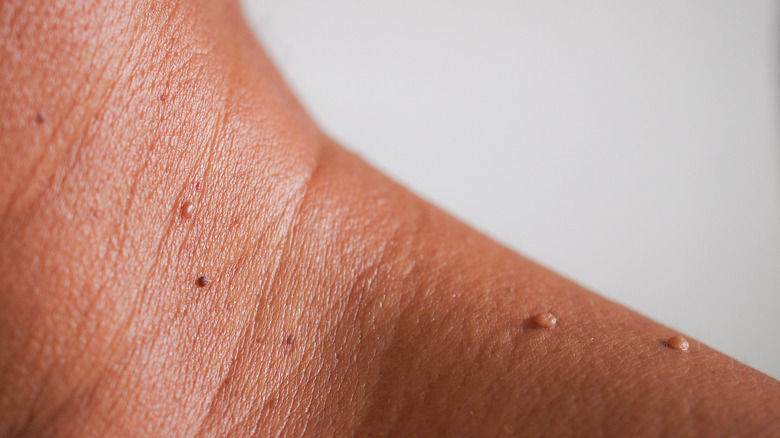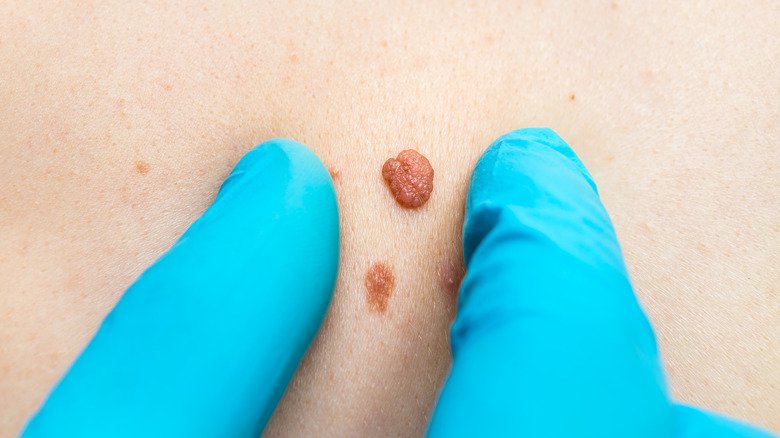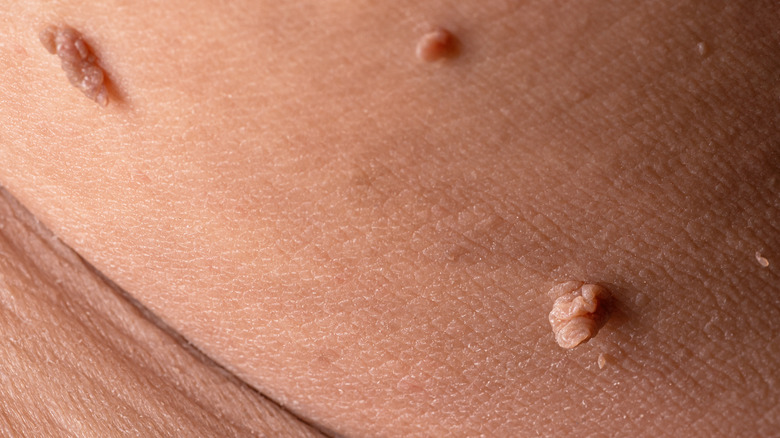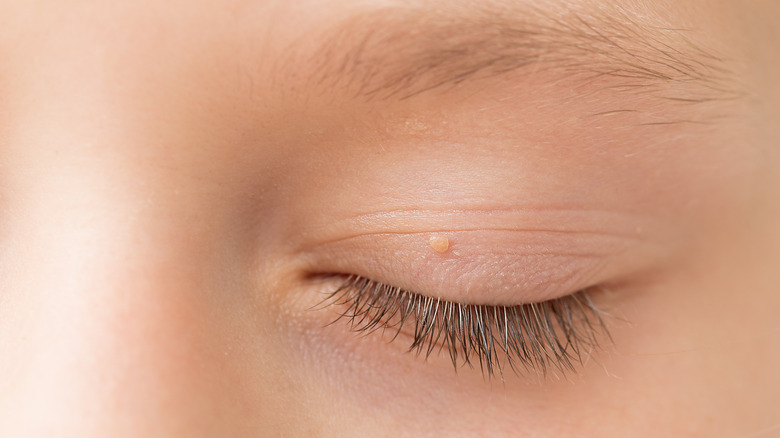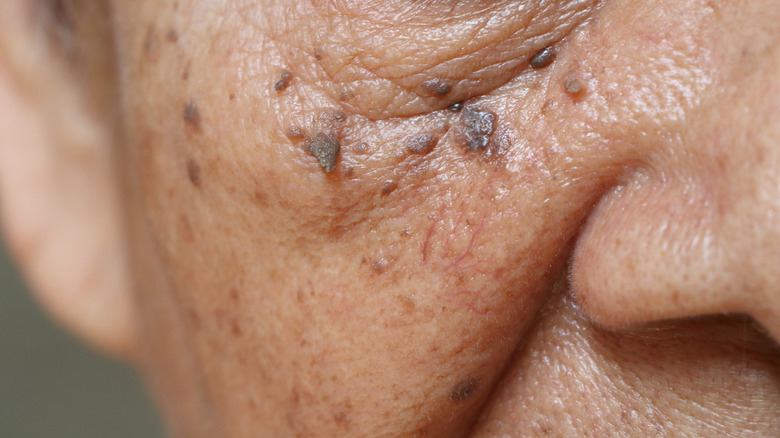Myths You Should Stop Believing About Skin Tags
Skin tags can seem mysterious, but these tiny little flaps of skin are usually nothing to think twice about. Still, there are a lot of misconceptions about skin tags that might leave you feeling unsure if you notice one pop up. Here's what to believe.
Skin tags, also called acrochordons, are really common, and it's estimated that half of all adults will develop at least one skin tag over the course of their lives (via Cleveland Clinic). Skin tags form when the body produces excess skin cells in one particular area, leading to a growth in the skin's top layers.
Skin tags are technically tumors of the skin, but they're benign, meaning they're not dangerous (via Medical News Today). The soft, hanging skin usually starts as a small bump like a pinhead, and sometimes falls off painlessly. You might not even notice them, and other times they appear in a prominent place and grow larger.
Per Cleveland Clinic, skin tags tend to appear in areas where the skin folds or rubs, like on the eyelids, armpits, under the breasts, groin, genitals, and neck. They might be flesh-colored or slightly darker, and usually grow on fleshy peduncles, or stalks, making them protrude from the skin.
Here are some myths about skin tags that you should consider leaving behind.
They could be cancerous
Even though growths on your skin might seem like cause for concern, in the case of skin tags, they're usually not (via The Healthy). Skin tags are nearly always benign. Some people choose to have them removed, but this is usually for cosmetic reasons, not health concerns.
Skin tags tend to stay relatively small, but if they get bigger and you notice other changes, you might want to get checked just to be sure. In very rare cases, some types of skin cancer might be mistaken for a skin tag, like squamous cell carcinoma, basal cell carcinoma, and melanoma.
If you notice a skin tag growing, itching, bleeding, or turning into a different color, then have it seen by a dermatologist to be safe. Dr. Avnee Shah, a dermatologist in Rutherford, New Jersey, recommends going to a board-certified dermatologist so they can inspect the growth and determine your risk (per The Healthy).
You can remove them at home
While it may be tempting to just get rid of a skin tag on your own at home (after all, it's just skin, right?), that's not such a good idea (via Cleveland Clinic). There are many different at-home products you can buy to try to get rid of skin tags yourself, but these are not safe.
Cleveland Clinic warns that without professional help, you could only partially remove the skin tag, meaning it will likely come back. You could accidentally use a product on something that you think is a skin tag, but could actually be a more serious skin condition. You're also more at risk for scars, bleeding, infection, and damage to surrounding skin.
Going to a dermatologist for a closer look and professional removal is your best bet. They can remove it through cryosurgery, or freezing it off with liquid nitrogen (per Harvard Health Publishing). They might also opt for electrocautery, which is when it's burned off with an electric probe or needle, or excision, when it's carefully removed with medical scissors.
If you remove one, more will grow
There's currently no scientific proof that removing a skin tag will cause more to grow, according to Medical News Today. It's perfectly safe to get them removed by a doctor, and doing so won't trigger more to develop in the future.
However, removing a skin tag doesn't mean that another one won't pop up (via The Healthy). You could remove every skin tag you have, and still develop more at another point. Doctors aren't able to prevent new skin tags from forming, so have reasonable expectations if you decide to get one removed.
You can help to prevent skin tags on your own, according to the Cleveland Clinic. Supporting a healthy weight, staying away from clothing or jewelry that may cause friction against the skin, and getting regular physical activity may help. It's been shown that skin tags can be more common in those who are overweight, experience insulin resistance, or have diabetes, so maintaining a healthy weight could lower your risk, explains The Healthy.
They're only for older folks
Skin tags can happen to anyone, not just your grandma. While it's true that they are more likely to develop on those who are over 60 years old, they can also be present on children, young adults, and those in middle age (via Healthline). Those who are going through hormonal changes, like pregnancy, might be more likely to get skin tags.
While the exact cause of skin tags isn't completely known, it's often thought that it may have to do with skin rubbing against other skin or clothing and causing friction, which could happen to anyone (via Windsor Dermatology).
Additionally, they're not contagious (via The Healthy). Therefore, hugging someone who has skin tags isn't going to cause you to develop them yourself. There's always a chance you could get them in the future though, so if you hug a loved one and then notice a skin tag, it's just a coincidence.
Anything that's protruding from your skin is a skin tag
If you notice a growth on your skin, it doesn't automatically mean it's a skin tag (via The Healthy). Some skin conditions that can resemble a skin tag are moles and seborrheic keratoses, which are other kinds of benign skin growths.
It could also be something more serious, like genital warts, which requires treatment from a doctor. The Healthy warns that sometimes, the glands on the skin could create growths that look like skin tags, and messing with them could cause them to become infected.
If your bump is pigmented, or it changes, then you should have it inspected by a professional. A dermatologist will evaluate the skin tag, but there's no test that definitively diagnoses it (via Cleveland Clinic). They'll ask you some questions about your health history and may decide to take a biopsy if they're concerned it could be something other than a skin tag.

